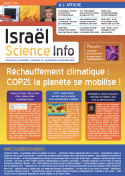Giant algal blooms periodically appear over hundreds of kilometers of ocean – so large they can be observed from space. Such blooms then disappear rapidly, within a week or two. The single-celled creatures called phytoplankton that make up these blooms die off from rampant viral infection, a fact that the Weizmann Institute’s Dr. Assaf Vardi of the Plant and Environmental Sciences Department has helped establish. The rapid demise of so many trillions of microorganisms over such a wide range must surely be one of the more impressive mass viral infection events on the face of the planet. Now a several-year multidisciplinary effort by Vardi and Prof. Ilan Koren – a theoretical physicist in the Earth and Planetary Sciences Department whose main area of research is cloud formation – has revealed how the virus can move so swiftly through the bloom.
The life cycle of the tiny but populous phytoplankton plays a vital role in maintaining the planet: It forms the basis of the marine food chain. These photosynthetic organisms take in carbon dioxide and release oxygen into the atmosphere; and they tie up carbon in the hard shells they build around themselves. In other words, their cycles of health and illness are of consequence to our own well-being.
Vardi and Koren thought that the answer to the quick disappearance of the algal blooms might be found somewhere in the intersection of their two disciplines: in the layer of atmosphere between the marine biosphere and the clouds. The sea breezes that move sailboats across the water could carry viruses a fair distance across a bloom to create new centers of infection.
The researchers had first asked this question three years ago, when Vardi organized an international research cruise together with several groups from Rutgers University and Woods Hole Oceanography institute that crossed the Atlantic from the equator north to Iceland. Vardi and Koren’s labs designed a research apparatus that was rigged to a mast on the ship to see if they could detect any of the viruses in the atmosphere several meters above the water. And they did, indeed, find viruses in the air over an algal bloom. Some of those viruses were a strain that Vardi had previously found to exclusively infect the species of phytoplankton in the blooms.
On the one hand the idea of airborne infection is hardly new – many human diseases, including the common cold, are spread by viruses in the air. On the other, there were any number of reasons to doubt that the phytoplankton viruses spread in this manner. For one, the virus, which is adapted to just one host, cannot remain viable for long once it leaves that host. For another, it would have to somehow exit the water and get into the air. And once in the air, it would be subjected to drying and DNA-destroying ultraviolet radiation. And if the virus survived all of this, it would have to be dropped back into the water near a convenient host.
For the next two years, Vardi, Koren and their teams, including Miri Trainic and Yoav Lehahn of the Earth and Planetary Sciences Department, Daniella Schatz of the Plant and Environmental Sciences Department and Shlomit Sharoni of both departments, investigated the results of the cruise findings in the lab, under an electron microscope and on their computers, asking whether airborne viral transmission could somehow be the key to the demise of algal blooms.
“Being a plankton-infecting virus is a bit like playing the lottery,” says Koren. Indeed all of the obstacles and dangers on the way are real and likely to be lethal. But the few viruses in a million that do make it all the way gain new hosts and new machinery for replicating themselves. And the payoff for these survivors is great: “Put in one virus and you’ll get a thousand new ones,” says Vardi.
The math showed that even if only a small fraction of the viruses are wafted in the breeze to new hosts, the overall infection rate will be high – hundreds or thousands of times higher than that possible if the viruses were carried from one plankton to another in the water, even taking waves and turbulence into account. A typical wind, they calculated, can carry 10 million viruses from an infected spot to new ones hundreds of kilometers away. A check of the weather conditions at the time of the bloom the team had studied revealed that the ocean breeze was just right to carry the viruses aloft for several hours and drop them far away but still, in the case of many, over patches of bloom.
“Among other things,” says Vardi, “the ancient battle between host and virus is played out here on a grand scale.” “When the phytoplankton die,” adds Koren, “their carbon-based shells burst open, and we are still not sure how this carbon cycles through the environment. We think that some of it also ends up in the atmosphere, even as some sinks permanently to the bottom. So understanding the tactics of each side in the battle can tell us something about where the Earth’s carbon ends up.”
Publication in PNAS, April 2015




















